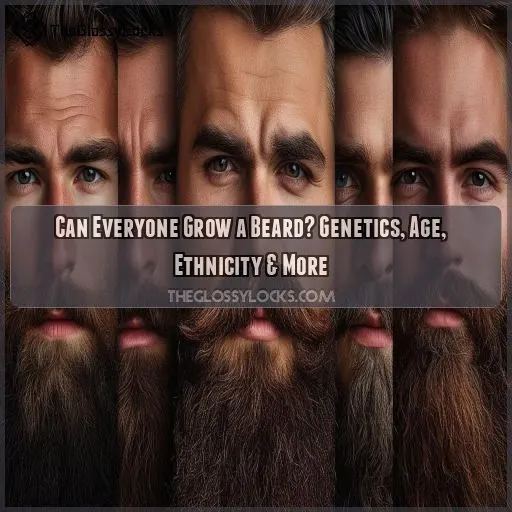This site is supported by our readers. We may earn a commission, at no cost to you, if you purchase through links.

It depends on a mix of genetics, age, and hormone levels.
If your dad and grandpa have thick beards, you’re likely to follow suit.
Ethnicity matters, too. Some ethnicities tend to have less facial hair than others.
And age is a factor—most guys achieve a full beard by 18, but it can take until your 30s to reach its full potential.
Table Of Contents
- Key Takeaways
- Can Everyone Grow a Beard?
- Signs You Can Grow a Beard
- Factors Affecting Beard Growth
- How to Grow a Beard Faster and Naturally
- Beard Growth Misconceptions
- 7 Signs You Can’t Grow a Beard
- Ways to Stimulate Beard Growth
- Embracing Your Beard Growth Potential
- Frequently Asked Questions (FAQs)
- Can every man eventually grow a beard?
- Is it possible to never be able to grow a beard?
- Can I grow a beard if my dad can’t?
- How do you know if you can grow a beard?
- What are the signs that I can grow a beard?
- How does my age affect my beard growth?
- Can I grow a beard if I have alopecia?
- Will growing a beard make me look older?
- How can I fix a patchy beard?
- Conclusion
Key Takeaways
- It’s not just about genes: While genetics play a big part, your age, ethnicity, health, and lifestyle choices also influence your beard-growing potential. It’s a team effort!
- Patchy beards aren’t the end of the world: If your beard’s looking a little sparse, don’t stress. Most guys achieve their full beard potential by their 30s, so give it time and nurture it with a healthy lifestyle and skincare routine.
- Stress less, beard more: High-stress levels can mess with your beard growth, so find ways to chill out. Yoga, meditation, or just kicking back might be your beard’s best friend.
- Beard facts, not fiction: Shaving doesn’t make your beard grow back thicker. Sorry, guys! It’s a common misconception. Focus on genetics, age, and lifestyle choices instead to enhance your beard game.
Can Everyone Grow a Beard?
Beards have become a symbol of masculinity and style, but can everyone join the bearded brotherhood? It’s time to explore the factors that influence your ability to grow a beard and answer the question on every hair-curious man’s mind.
The Role of Genetics
Genetics play a big part in how much beard you can grow. Here are three things to think about:
- Family History: Take a look at your dad and grandad. If they’ve thin or uneven beards, chances are you might too.
- Dominant Genes: Paternal genes often have the biggest say in how facial hair grows. So, blame your dad if your beard dreams don’t come true!
- Beard Implantation: If your genes aren’t doing you any favors, don’t worry. Modern medicine has surgical procedures to help you get the beard you want.
Impact of Age and Puberty
Puberty and age play a significant role in beard growth.
Typically, beard growth begins during puberty, between 13 and 19 years old.
Hitting puberty early gives you a better chance of growing a full, dense beard.
Most guys achieve a full beard by 18, but it can take until your 30s for your beard to reach its full potential.
Ethnicity and Facial Hair Variation
Ethnicity plays a significant role in determining your beard growth potential. Here’s what you need to know:
- Facial Hair Trends: Some ethnicities, like Chinese, Mexican, and Native American men, tend to have less facial hair than Caucasian men. This doesn’t mean it’s impossible for them to grow beards, but the density and coverage may vary.
- Genetic Differences: The variation in beard growth across ethnicities is primarily due to genetic differences. Your genetic makeup influences the density, thickness, and overall growth pattern of your facial hair.
- Ethnic Beard Styles: Embrace your unique beard growth pattern! Different ethnicities have distinct beard styles that can be celebrated and styled accordingly. Explore ethnic beard styles that complement your natural growth pattern.
- Cultural Perceptions: Facial hair is perceived differently across cultures. Some cultures may associate beards with masculinity, wisdom, or even religious beliefs. Understanding these cultural perceptions can influence your decision to grow or style your beard.
- Embrace Your Uniqueness: Everyone’s beard growth journey is unique. Instead of comparing yourself to others, focus on maintaining a healthy beard and embracing your natural growth pattern.
Health and Lifestyle Factors
Turns out there’s more to growing a beard than just genetics and ethnicity. Your health and lifestyle habits also play a huge role in whether you can rock a full beard or not.
First up, stress. High-stress levels can mess with your hair growth, including your beard. So, if you’re constantly stressed, that could be holding back your beard’s potential. Find ways to chill out and manage that stress. Maybe try some yoga, meditation, or just kick back and relax.
Next, your diet and exercise routine. A healthy diet, packed with fruits, veggies, and seafood, gives your body the nutrients it needs for beard growth. Omega-3 fatty acids and biotin are like superfoods for your beard. And don’t forget to move that body! Exercise boosts testosterone and improves blood circulation, both of which are key for a healthy beard.
Sleep is another big player in the beard game. You need those Zzz’s to keep your hormones in check. When you’re well-rested, your body produces the right amount of testosterone to support beard growth.
Signs You Can Grow a Beard
So, can you grow a beard? It’s a question many guys ask themselves. Luckily, there are some tell-tale signs that indicate your beard-growing potential.
If you’re keen to find out whether you can join the ranks of the bearded, read on to discover the clues your body may be giving you.
Family History of Beard Growth
If you’re wondering whether you’ll be able to grow a beard, one of the most telling signs is in your family history. Take a look at your father and grandfathers’ beards—if they’ve got thick, lush facial hair, chances are you’ll follow suit. It’s all about those genetic traits being passed down through the generations.
Here are some key points to keep in mind:
- Genetic Traits: Paternal genes often play a bigger role when it comes to facial hair growth patterns. So, if your dad and grandad have impressive beards, you’re likely to carry the same genetic advantage.
- Facial Hair Patterns: Take note of the facial hair patterns in your family. Do your male relatives tend to have full beards, or is it more of a patchy situation? Family resemblance can give you a good indication of what to expect.
- Beard Genetics: The presence of specific genes related to beard growth can be inherited from your family. These genes influence the sensitivity of your hair follicles to the hormone DHT, which plays a key role in beard growth during the anagen (growth) and telogen (resting) phases.
- Family History: If your male relatives struggled to grow beards, it mightn’t be a good sign for your own facial hair aspirations. However, remember that genetics is a complex field, and other factors like age, ethnicity, and lifestyle can also influence your beard growth potential.
Body Hair Indicators
If you’ve got hair on your chest, arms, legs, and back, you’re likely to be able to grow a beard. It’s a good sign that your body is producing the right hormones for facial hair growth. Think of it as nature’s way of giving you a preview of your beard potential.
Healthy Diet and Lifestyle
Eating a healthy, balanced diet with the right nutrients is key to supporting beard growth.
Aim for foods rich in omega-3 fatty acids and biotin, like seafood and nuts.
Don’t forget your fruits and veggies, too.
A well-rounded diet provides the vitamins and minerals needed for healthy hair.
Think of it like this: Your beard is like a garden. You need to give it the right nutrients and water (hydration is key!) to help it grow strong and lush.
Good Stress Management Capacity
Stress management is an important factor in beard growth. High cortisol levels, which are associated with stress, can inhibit testosterone production and hinder beard growth. Here are some tips to help you keep stress levels in check:
- Meditation and Yoga: These practices can help you relax, reduce stress, and improve your overall well-being.
- Exercise: Regular physical activity boosts testosterone levels and improves blood circulation, which can promote beard growth.
- Relaxation Techniques: Find what works for you, whether it’s spending time in nature, listening to music, or engaging in a hobby.
- Sleep: Get enough shut-eye! Adequate sleep is key for maintaining healthy hormone levels, which are essential for beard growth.
Factors Affecting Beard Growth
So, you’re curious about what makes beards grow? From genetics and age to hormones and lifestyle, there’s a whole bunch of factors that speed up or slow down beard growth and affect how thick it gets.
Hormonal Influence on Beard Hair
Testosterone and Dihydrotestosterone (DHT) are the key players when it comes to hormonal influence on beard growth. These hormones are like the conductors of an orchestra, directing your facial hair to flourish. But it’s not just about their presence; it’s also about their levels and how they interact with your body.
| Hormone | Function | Impact on Beard Growth |
|---|---|---|
| Testosterone | Key hormone for beard growth | Stimulates hair follicles |
| DHT | Derived from testosterone | Binds to receptors in hair follicles, impacting growth |
Understanding the interplay between these hormones and your unique biology is key to figuring out the potential of your beard.
The Science Behind Beard Growth Cycle
Now that we’ve explored the hormonal influence on beard hair, let’s take a closer look at the science behind the beard growth cycle. Your beard hair goes through four phases: Anagen (active growth), Catagen (transition), Telogen (resting), and Terminal Length (end of growth). Here are three key factors affecting your beard growth:
- Genetics: Your family history and ethnicity play a significant role in determining your beard growth potential.
- Hormone levels: Testosterone and Dihydrotestosterone (DHT) levels influence your beard hair growth.
- Lifestyle choices: A healthy diet, regular exercise, and stress management can promote healthy beard growth.
Terminal Beard Length and Growth Regions
Your beard growth journey involves understanding terminal beard length and the regions where beard hair tends to flourish.
The average terminal length ranges from 12 to 36 inches.
While beards continuously produce new hairs, individual hairs reach a certain length before stopping.
The mustache, soul patch, goatee, sideburns, and neck are the prime real estate for beard growth, but remember, each beard is unique!
Does Your Beard Ever Stop Growing?
Your beard will continuously produce hairs throughout your life, but individual hairs have their limits. Each hair reaches a terminal length and is eventually replaced by new growth. So, while your beard as a whole keeps growing, each hair has a lifespan and a specific length it won’t exceed.
How to Grow a Beard Faster and Naturally
Growing a beard is a commitment, and there are ways to speed up the process naturally. In this section, we’ll share tips on how to grow a beard faster, from embracing the initial awkward stages to incorporating beard-friendly habits into your routine.
Patience and Commitment
So, you’ve decided to grow a beard. You’ve got the vision, but now you need the patience and commitment to see it through. Here’s a simple guide to help you navigate the early stages of your beard growth journey:
- Beard Growth Timeline: Growing a beard is a process, and it can take time to reach your desired length and fullness. Be prepared for a journey that may last several weeks, months, or even years.
- Patience vs. Expectations: It’s important to manage your expectations. Beard growth can be unpredictable, and it may not always live up to your initial vision. Embrace the uniqueness of your beard and enjoy the process.
- Early Stages of Growth: The first few weeks can be challenging. You may experience itchiness, unevenness, or patchiness. Resist the urge to shave and let your beard grow freely.
- Trimming & Shaping: After 4-6 weeks, you can start shaping your beard. This is where your vision comes to life. Define your neckline, cheek lines, and mustache style.
- Beard Care Tips: Invest in quality beard care products like oils, washes, and combs to keep your beard healthy and nourished. A healthy beard is a good-looking beard!
Healthy Diet and Omega-3 Fatty Acids
Eating a healthy diet with the right nutrients is essential for beard growth.
You need to make sure you’re getting enough protein, omega-3 fatty acids, and vitamins.
Omega-3 fatty acids are found in seafood like salmon, tuna, and sardines, as well as plant sources like flaxseeds, chia seeds, and walnuts.
These healthy fats promote hair growth and keep your skin and hair hydrated.
Reduce Stress and Get Enough Sleep
Beard growth isn’t just about what you put on your face; it’s also about what’s going on inside your body. Stress and sleep are two key factors that influence your hormones and, ultimately, your beard growth. When you’re stressed, your body produces higher levels of cortisol, which can interfere with testosterone production and hinder beard growth. So, finding ways to chill out and manage your stress is key. Maybe try some meditation, yoga, or even just a walk in nature to unwind.
Sleep is also essential to give your body the downtime it needs to produce those all-important hormones. Aim for a solid 7-9 hours each night to keep your beard growth on track.
Avoid Smoking and Unhealthy Habits
Kicking unhealthy habits, like smoking, is key to boosting beard growth. We get it, breaking up is hard to do, but your beard will thank you.
Nicotine and other toxins in cigarettes mess with your hair follicles, stunting growth. So, stub it out and say sayonara to smoking. Your beard, and your health, will be better off without it.
Beard Growth Misconceptions
Despite what you may have heard, shaving doesn’t make your beard grow back thicker or faster. Let’s separate fact from fiction and explore the myths surrounding beard growth.
Shaving Doesn’t Affect Your Hair
Contrary to popular belief, shaving doesn’t make your beard hair grow back thicker or faster. Here are some key points to remember:
- Shaving simply cuts the hair at the surface, giving the illusion of thicker growth.
- Your hair growth rate and texture remain unchanged, regardless of how often you shave.
- The idea that shaving affects hair growth is a common misconception.
- Focus on other factors like genetics, age, and lifestyle choices to enhance your beard growth potential.
It’s Not All About Testosterone
It’s a common misconception that testosterone is the sole hormone responsible for beard growth. While it does play a big role, other factors are at play, too.
Testosterone is important, but it’s not the only thing that matters. Don’t fall into the trap of thinking that a lack of testosterone is the end-all and be-all of beard growth. There are other factors at play that can influence your ability to grow a beard.
Debunking the Magic Pill Myth
Unfortunately, there’s no magic pill or potion that will instantly give you the beard of your dreams. While the market is flooded with beard growth supplements and products that promise miraculous results, the truth is a little less exciting. Here are the facts:
- No Scientific Evidence: There’s no scientific evidence to support the effectiveness of beard growth supplements or products. The claims made by these companies are often exaggerated or unfounded.
- Natural Remedies: While natural remedies like beard oils, balms, and washes can help nourish and moisturize your beard, they won’t directly impact hair growth. These products are more about beard maintenance than actual growth.
- Healthy Habits: A healthy lifestyle, including a balanced diet, exercise, and stress management, is key to supporting overall beard health. These habits can create a good environment for beard growth, but they won’t instantly accelerate it.
- Patience is Key: Beard growth is a natural process that takes time. Instead of seeking quick fixes, embrace the journey and focus on maintaining a healthy beard and a healthy you.
7 Signs You Can’t Grow a Beard
So, you’re wondering why your beard isn’t thriving. Let’s get straight to the point and uncover the seven signs that might be hindering your beard growth. From low testosterone levels to lifestyle choices, we’ll explore the factors that could be holding you back from achieving your facial hair goals.
Low Testosterone Levels
Low testosterone levels can be a significant hurdle to growing a beard. If you’re experiencing signs of low testosterone, also known as "Low T," it may be challenging to achieve the facial hair of your dreams. Here’s what you need to know:
| Sign | Description | Action |
|---|---|---|
| 1 | Fatigue and Low Energy | Consult a doctor for medical advice. |
| 2 | Reduced Muscle Mass | Consider Testosterone Replacement Therapy. |
| 3 | Increased Body Fat | Adopt lifestyle changes for overall health. |
Unhealthy Diet and Lifestyle
An unhealthy diet and lifestyle can hinder your beard-growing aspirations. Here are some signs that your lifestyle may be holding you back:
- You’re not eating a balanced diet rich in fruits, veggies, and seafood.
- You’re skipping out on essential nutrients like Omega-3 fatty acids and biotin.
- You’re neglecting your body’s need for regular exercise.
- You’re not prioritizing adequate sleep, which is key for hormone regulation and overall health.
High Stress and Poor Sleep
High stress and poor sleep can be major roadblocks to your beard growth journey. Stress can suppress testosterone production and constrict blood vessels, creating an unfavorable environment for healthy hair growth. If you’re constantly stressed, your body produces higher levels of cortisol, a stress hormone that can hinder beard growth.
To give your beard the best chance, focus on stress management techniques like yoga, meditation, or spending time in nature. Getting enough quality sleep is also really important, as it allows your body to produce the hormones necessary for beard growth.
Alopecia Areata and Autoimmune Conditions
Unfortunately, sometimes, you just can’t grow a beard. One of the reasons for this could be Alopecia Areata.
Alopecia Areata is an autoimmune condition that can cause hair loss on your scalp, face, and body. It can really impact your beard growth, leaving you with patchy or uneven facial hair. Here are some signs that you may have this condition:
- Patchy hair loss on your scalp, face, or body
- Round or oval bald spots
- Sudden hair loss in one or more areas
- Hair loss in your nails, causing them to become brittle, pitted, or grooved
If you think you may have Alopecia Areata, it’s important to consult a dermatologist for a proper diagnosis and treatment plan. While there’s no cure for this condition, treatments can help manage symptoms and promote hair regrowth.
Ways to Stimulate Beard Growth
If you want to boost your beard growth, you’re in luck. We’ve got the lowdown on simple yet effective strategies to get that facial hair flourishing. From skincare secrets to diet and exercise, we’ll reveal the science-backed ways to stimulate beard growth and help you achieve your whiskery goals.
Skincare Routine and Exfoliation
A consistent skincare routine is essential for healthy beard growth. Exfoliating your skin regularly helps remove dead skin cells, unclogs pores, and promotes beard growth. You can use exfoliating tools like beard scrubs or a gentle cleanser to achieve this. However, be cautious not to over-exfoliate, as this may irritate your skin. While there are no specific guidelines for exfoliation frequency, 2–3 times a week is generally recommended. If you’re feeling adventurous, you can even try DIY exfoliation with natural ingredients like sugar or coffee grounds.
As for beard care routines for children or pets, it’s best to consult a dermatologist or veterinarian, respectively, for specialized advice.
Beard Care and Nourishment
Now that you’ve established a solid skincare routine, it’s time to focus on beard care. Here are some tips to nourish and stimulate your beard growth:
- Beard Oil Benefits: Beard oil is like a superfood for your facial hair. It hydrates and softens your beard, making it look healthier and feel more manageable. Look for oils with biotin, argan, or jojoba oil to promote growth.
- Beard Wash Routine: A good beard wash or shampoo is essential to keep your beard clean and healthy. Aim for a gentle, moisturizing formula that won’t strip your beard of its natural oils.
- Beard Trimming Tips: While it’s tempting to trim your beard often, try to resist. Let it grow for at least a month before shaping it. This allows for a fuller, more even growth pattern.
Diet and Exercise for Hair Health
A healthy diet and regular exercise are key to supporting hair health and stimulating beard growth. Aim for a diet rich in protein-rich foods like meat, fish, beans, and nuts. These provide the essential amino acids that promote hair growth and strengthen hair follicles.
Also, focus on hair-boosting vitamins like biotin, vitamin A, and vitamin B6, which you can get from fruits and vegetables. Don’t forget to stay hydrated, as water delivers nutrients to hair follicles and promotes healthy beard growth.
Exercise improves blood circulation, boosting the delivery of nutrients to your hair follicles and increasing testosterone levels, which can lead to thicker beard growth. So, get moving!
Supplements and Vitamins for Beard Growth
While a healthy diet is key, some guys opt for supplements to boost beard growth. Popular ones include biotin, vitamin A, and zinc. But before you pop those pills, chat with your doc. They’ll guide you on what’s best and if supplements are even worth it for your body.
Embracing Your Beard Growth Potential
Genetics play a massive role in determining your beard growth potential. While you can’t change your genes, you can embrace what nature has given you and focus on maintaining a healthy beard. It’s also important to remember that other factors, like age, ethnicity, testosterone levels, and underlying health conditions, can impact your beard growth.
Accepting Your Natural Beard Growth
Beard growth is a journey, and like any journey, it’s unique to each person. You might be excited to grow a lush, full beard, but it’s important to accept and embrace your natural beard growth potential. Here’s why:
- Embrace Your Genetics: Your genes play a huge role in how your beard grows. If your dad or grandad sported a thin or patchy beard, you might follow a similar path. It’s all about accepting and working with what you’ve got.
- Ethnicity and Facial Hair: Different ethnicities have varying facial hair patterns. Maybe you’re of Chinese, Mexican, or Native American descent, where facial hair tends to be less prominent. It’s all part of your unique heritage.
- Age is Just a Number: Beard growth can continue into your 30s and beyond. While some guys peak in their 20s, others take a little longer to reach their full beard potential. It’s a marathon, not a sprint.
- You’re More Than Your Beard: Remember, your worth isn’t defined by your beard’s thickness or fullness. Confidence comes from within, and embracing your natural self is a powerful form of self-love.
Focusing on Healthy Lifestyle Choices
Embracing your beard growth potential means making healthy lifestyle choices. A balanced diet, regular exercise, and adequate sleep are key. Focus on protein, omega-3 fatty acids, and vitamins to support hair health. Manage stress through yoga or meditation, and avoid smoking to keep your beard game strong.
Utilizing Beard Growth Stimulation Techniques
Now that you’ve embraced healthy lifestyle choices, it’s time to focus on specific techniques to enhance your beard growth potential. Here are some practical steps to follow:
- Beard care routine: Invest in quality beard oils, washes, and combs to nourish, clean, and style your beard.
- Diet for beards: Make sure your diet is rich in proteins, fruits, and vegetables, especially those containing biotin, vitamin A, and vitamin B6.
- Growth supplements: Consult a doctor about taking biotin, vitamin A, and vitamin B6 supplements to boost hair growth.
Frequently Asked Questions (FAQs)
Can every man eventually grow a beard?
Nope. Beard growth depends on genetics, age, ethnicity, health, and lifestyle. Some men can’t grow full beards due to these factors.
Is it possible to never be able to grow a beard?
Yes, it’s possible to never be able to grow a full beard due to genetics, ethnicity, age, health conditions, and other factors. It’s not just about waiting—some people can’t grow one at all.
Can I grow a beard if my dad can’t?
While your dad’s genes may influence your beard growth, it’s not the only factor. Beard growth patterns are affected by a mix of genetic and environmental factors from both sides of your family. So, if your dad can’t grow a beard, it doesn’t mean you can’t either.
How do you know if you can grow a beard?
Genetics play a major role in your beard-growing potential. Other factors include age, ethnicity, testosterone levels, and lifestyle choices. Consult a doctor or dermatologist for personalized advice.
What are the signs that I can grow a beard?
A lion’s mane doesn’t appear overnight, but some signs indicate your beard is on its way. Look out for light-colored hairs, itchy skin, and genetics—if your dad’s got a thick beard, you might too.
How does my age affect my beard growth?
Age can play a role in beard growth. Peak beard growth typically occurs between the ages of 25 and 35, when testosterone levels are highest. As you age, testosterone levels naturally decrease, leading to thinner and slower beard growth.
Can I grow a beard if I have alopecia?
Alopecia barbae is an autoimmune condition that causes hair loss in the beard area. While there’s no cure, if you have one patch, there’s a good chance it’ll regrow over time. See a dermatologist for an honest assessment.
Will growing a beard make me look older?
According to a 2013 study, a beard can make you look about eight years older. So, if you want to appear older, grow a beard. If you want to look younger, keep your facial hair trimmed and well-groomed.
How can I fix a patchy beard?
Give your beard time to grow, and consider using a boar’s hair brush to direct longer hairs over thinner spots. Sea salt spray can also help give the appearance of a fuller beard.
Conclusion
Can everyone grow a beard? It’s a mix of genes, age, and ethnicity.
Most guys will reach their full beard potential by their 30s.
If you’re keen to speed things up, focus on a healthy lifestyle, stress management, and a balanced diet.
Embrace the beard you can grow, and if needed, give it a nudge with skincare and supplements.
It’s your unique facial hair journey, so enjoy the ride!










